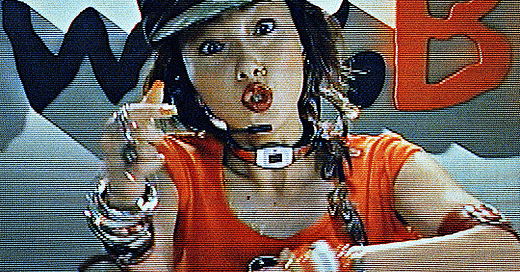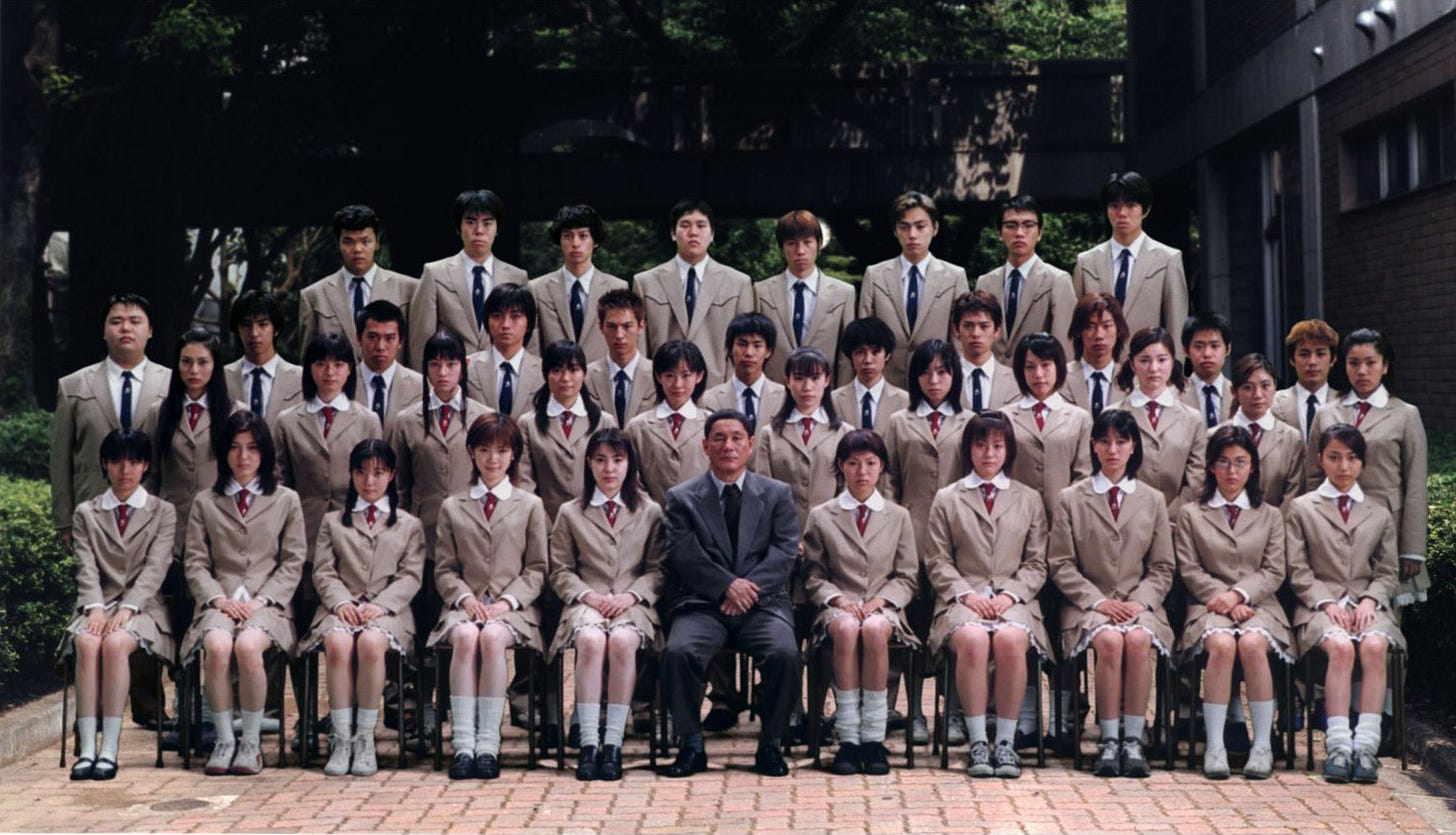Battle Royale vs. The Hunger Games
A deep dive into the cultural legacy of Japan's premiere death games
A few nights ago I finished reading Sunrise on the Reaping by Suzanne Collins and sat down to review it, but found my thoughts straying to Battle Royale, the novel, film, and manga series that won my heart long before I ever heard of the The Hunger Games.
I’m P M Buchan, a former comic-book writer and lover of horror and dark art. I’ve written monthly columns and comic strips for Starburst and SCREAM: The Horror Magazine. I’ve collaborated with award-winning artists including John Pearson, Martin Simmonds and Ben Templesmith, and have been interviewed by Kerrang! and Rue Morgue. My work has been reviewed by Famous Monsters of Filmland, Fortean Times and Times Literary Supplement. I’ve collaborated with bands including Megadeth and Harley Poe, and written for clients including Lionsgate and Heavy Metal Magazine.
Read on for a deep dive into the cultural legacy of Koushun Takami’s Battle Royale versus Collins’ Hunger Games, exploring my 20+ year obsession with Takami's masterpiece and why it continues to matter. From its controversial reception in Japan to its lasting cultural impact, discover why Battle Royale remains the world-leading narrative about teenagers killing teenagers, despite Hunger Games' commercial dominance.
First love never dies
The Battle Royale novel was written by Koushun Takami in 1996 but not published in Japan until 1999, being adapted by the author into a manga series beginning in 2000. In the same year it was adapted into a feature film, directed by Kinji Fukasaku and written by his son Kenta Fukasaku. The film version of Battle Royale was released in Japan in December 2000, then in the UK in 2001. Critical reception in the UK and Europe was impressive, but Battle Royale failed to land a cinematic release (outside of limited film festivals) in the US until 2011, which undoubtedly diminished the film’s English-language legacy.
I first watched Battle Royale in September 2002, when I bought Tartan Video's steelbook, containing the Special Edition and original cut of the film. I was instantly mesmerised, falling in love and never looking back.
A lifelong obsession
The Battle Royale manga was published in Japan from 2000 to 2005, and published in North America (and distributed in the UK) by Tokyopop between 2003 and 2006. The novel was translated by Yuji Oniki and first released in English by Viz Media in February 2003.
I first started working in a comic-book store in Newcastle city centre mid-2004 and for the next couple of years my obsession with Battle Royale only grew, picking up the novel, collecting the manga, and evangelising for the series to customers who came into the store.
Around that time, British design consultancy Airside, founded by Alex Maclean, Nat Hunter and Fred Deakin, won the license to create some spectacular minimalist Battle Royale licensed t-shirts in the UK and I snapped one up, wishing that I could afford the full set. My love of Battle Royale was one of the driving forces behind my developing interest in Japanese culture and vain attempts to learn to speak Japanese at night classes, culminating in a trip to Japan with my wife where we visited Kyoto, Shikoku and Tokyo.
Why Battle Royale will always matter
Battle Royale is unquestionably a work of art, whatever medium you want to analyse. As the sole novel written by Koushun Takami, there's something magical there in having written one earth shattering book and no more. As a film, Battle Royale was the final achievement of Kinji Fukasaka, a man whose body of yakuza films had already secured his legacy in Japanese cinema.
There are so many threads to pull at when it comes to analysing why Battle Royale speaks to me so deeply, from the disenfranchisement of youth and the rallying cry to fight against a brutal, inevitable fate to the distance between the idealism of the teenage schoolchildren and the hollow nihilism of the adults in their lives.
Time and time again, however, I return to an article that Katherine Dee wrote about online fandom for teen high school shooters, and her quote that "When we're teenagers, our feelings are so big and the reality of our lives are often so small in comparison. The violence of a school shooting gives teen angst the gravitas it feels like it deserves: it offers catharsis." This, more than anything else, summarises why I'm drawn to stories about adolescence. There's a purity of emotion and intent, which in storytelling terms leads to an earned synchronicity between action and theme.
If you're telling stories about teen protagonists, you don't have to force theme and metaphor on the characters, because they have such rich inner worlds and forceful desires that they're crying out to manifest these feelings in the physical world. And that's maybe what I love so much about Battle Royale, the opportunity for these 42 desperate teenagers to manifest their desires and vocalise their emotions in a last ditch effort to live before they die. When 41 of your peers are trying to kill you, there are few excuses left to disguise your true motivations.
Exploding heads, cultural context and controversy
What many modern fans of Battle Royale might not realise is how controversial the film was in Japan when it was first released. The premise of schoolchildren engaged in ultra-violent slaughter led to fears about its influence on young people, particularly because it coincided with a period of high-profile juvenile crimes. Politicians seized on Battle Royale as a symbol of depravity before even watching it. Diet member Kouki Ishii led a campaign to ban the movie.
In interviews, Fukasaku spoke about inviting about 50 Diet members and education officials to a private screening, only to find "they came with a fixed prejudice" and weren't swayed. The film ultimately received an R-15+ rating in Japan, a rarity that barred most actual teens from seeing it on the big screen.
Ironically, this controversy became free publicity that generated wider interest. The film went on to gross ¥3.11 billion in Japan, making it the third highest-grossing domestic film of 2001.
For me, this adds another fascinating layer to the film's legacy. A work so provocative that authorities tried to suppress it now stands as a cultural touchstone, which is a perfect example of art's ability to challenge social norms and survive attempts at censorship.
Hollywood’s alternative
My feelings about the Hunger Games are more complicated, but less interesting. Suzanne Collins maintains that when she wrote the first book, she "had never heard of Battle Royale" and was "well into writing the second book" by the time she became aware of it. I think it’s unlikely she was completely unaware of Battle Royale, which came out only nine years before her novel did. Even knowing that the concept existed in the world, without having read the novel or watched the movie, might have unconsciously influenced her narrative choices.
Alan Moore has spoken before about the collective consciousness, the ideaspace that we take inspiration from, which can account for the ways that different people come up with such similar ideas at the same time, because by osmosis we're all absorbing similar influences and watching world events unfold together. You can tell me that Hunger Games wasn't influenced by Battle Royale, but the truth is almost certainly more nuanced than that.
The blockbuster machine
Regardless of where the idea came from, Hunger Games is a different beast to Battle Royale. The first book released alongside the last main release in the Twilight saga, a series of YA books that had softened up America and British markets and raised readership levels and anticipation for good teen novels with female protagonists. Hunger Games benefited from that publishing ecosystem and although ultimately the romance at the heart of the series was a distraction from the more Orwellian themes that Collins smuggled in, the romance was what helped sell the story to teenage audiences.
Collins does some interesting things with her central conceit and there's undoubtedly a subversive element to the Hunger Games franchise, but that's what it is – a blockbuster franchise, with matching budgets, marketing machines, and scrutiny. However much Collins draws readers awareness towards propaganda and media manipulation, there's always a certain flatness to the Hunger Games, a predictable style of storytelling and structure that follows the expected hero's journey rules and feels cookie-cutter and safe.
While Battle Royale went through controversy and censorship debates, The Hunger Games had a different trajectory. With the backing of a major Hollywood studio, it secured a wide and carefully managed release. There was little outright censorship controversy, which meant that a core audience of millions of teens got to see it in cinemas.
The Hunger Games premise of children killing children for sport should have been every bit as disturbing as Battle Royale's, but somehow Collins’ story was marketed as a heroic rebellion, which made the violence more palatable to American audiences, whereas Battle Royale was condemned for what was superficially interpreted as bleak nihilism.
Adult paranoia vs wartime propaganda
Despite surface similarities, the two works explore different themes that reflect the concerns of their respective societies.
Battle Royale is a biting allegory about mistrust between generations and authoritarian overreach. The dystopian government conducts the Battle Experiment Program ostensibly to research combat skills, but primarily to terrorize the population and prevent youth rebellion. This premise can be read as a satirical exaggeration of adult paranoia about delinquent youth, of a world terrified by the power of its young people.
Fukasaku interpreted the story through the lens of his wartime adolescence. In interviews, he drew parallels between the film's world and Japan's lost WWII generation: just as children in the film are betrayed by adult society, Fukasaku felt his generation was betrayed by the wartime government's follies. The result, he observed, was a postwar loss of communication between adults and youth: "The distrust...between adults and children is as strong as it was when I was 15. And it's getting even deeper. Adults have lost hope for tomorrow. Children have no hope for the future."
The Hunger Games, meanwhile, foregrounds themes of authoritarianism, class inequality, and the ethics of resistance. The Hunger Games themselves combine bread-and-circuses spectacle with terror: they are televised as reality TV, turning rebellion suppression into mass entertainment.
One standout theme in The Hunger Games is the power of media and image. The Capitol's use of the Games as televised fear tactic finds a counterpart in the rebel side's use of Katniss as the symbolic Mockingjay in propaganda broadcasts. This commentary on propaganda, celebrity, and the manufacturing of hope made the story feel very modern.
David vs Goliath in terms of cultural impact
When it comes to cultural impact, there's no comparison between the two works in terms of scale and reach. The Hunger Games films had budgets 10-20 times larger than Battle Royale. They generated merchandise, soundtracks, and spin-offs, a whole commercial ecosystem. Financially, there's no contest. The Hunger Games franchise grossed over 100 times what Battle Royale did.
Battle Royale as a term came to define a genre of video games, which feels like a paltry legacy for a brutally efficient work of art, but I suppose at least this trailblazing novel and film will be remembered in more ways than just as a cult classic.
The Hunger Games, on the other hand, achieved global pop culture saturation and became a touchstone for a generation. Terms and symbols from the series entered everyday pop culture: phrases like "May the odds be ever in your favor" became widely recognized, "Katniss" became a popular baby name for a time, and the three-finger salute became an icon of defiance, even being adopted by real-world protesters in Thailand in 2014 as a silent anti-coup symbol.
The lasting legacy of Battle Royale
I started writing this newsletter because I'd read the newest Hunger Games novel, Sunrise on the Reaping, and thought about reviewing it, but honestly, I don't have anything interesting to say about that novel. I enjoyed it, I'm not sorry to have read it and I'll be happy to see the movie when it comes out, but the story won't stay with me in any way. I wasn't touched by it and it won't change my life. If you want life-changing, best to stick with Battle Royale.
Battle Royale has only grown in stature over time. What started as a shocking cult provocateur is now often mentioned among the 21st century's influential films. You can see its influence bleed into media around the world, from Chiaki Kuriyama’s casting by Quentin Tarantino in Kill Bill to the burgeoning death games genre that defines manga series including Btooom! and Danganronpa, and international blockbuster TV series such as Squid Games.
By 2025, the film is openly celebrated in Japan: for its 25th anniversary, it even got a special commemorative theatrical re-release with fans flocking to see it on the big screen again. This is a remarkable arc from being semi-suppressed in 2000 to being honoured as a modern classic.
In the end, both Battle Royale and the Hunger Games both ask the same question that we all must face eventually: Do we accept the rules imposed by a cruel world, or do we fight them? But for me, there's a purity, an honesty, and a brutal poetry to Battle Royale that Hunger Games, for all its commercial success and wider reach, never quite achieves.
Battle Royale never tries to be palatable or marketable. Battle Royale is a great work of art that strives for honesty and authenticity, about the distance between adolescence and adulthood, and why we should all try harder to bridge that gap instead of pitting our children against each other. As I get older and closer to the character of Kitano than the teen protagonists, that’s a lesson that only gains more pathos and becomes more difficult to swallow.
Hunger Royale
You’ve persevered through my massive analysis of the cultural impact and legacy of Battle Royale, filtered through my unadulterated love for unrequited romance and teen dismemberment. By way of thanks, here’s my 2012 comic strip on the same subject with artist Chris Doherty, first published in the pages of Starburst Magazine.
There’s a good chance this strip will mean more to UK audiences than it will overseas. I’m not sure anybody who grew up elsewhere can understand just how much the class divide permeates literally everything about life and culture in England. The isolated, deprived North versus the metropolitan, opportunity-rich South. State council-run comprehensive schools versus the privately educated who go on to study PPE at Oxford or Cambridge University and dominate public life and policy.
Hunger Royale was my love letter to Battle Royale, but also my own small contribution to class warfare.
You might also enjoy
An interview with Lucy Sullivan
Lucy Sullivan is a Writer & Artist from London. Her acclaimed debut graphic novel Barking, based on the her own experience of a mental health crisis was first published during the pandemic and quickly sold out. Lucy recently worked on THE THING WITH FEATHERS flm starring Benedict Cumberbatch, adapted from the novel by Max Porter. Interview first published 9 May 2020.
– P M Buchan









Whenever I see "Battle Royale" (as opposed to "battle-royal") I always think of burgers. Which is no bad thing btw!